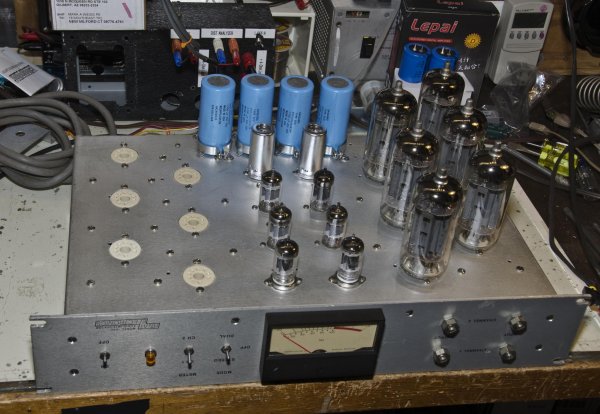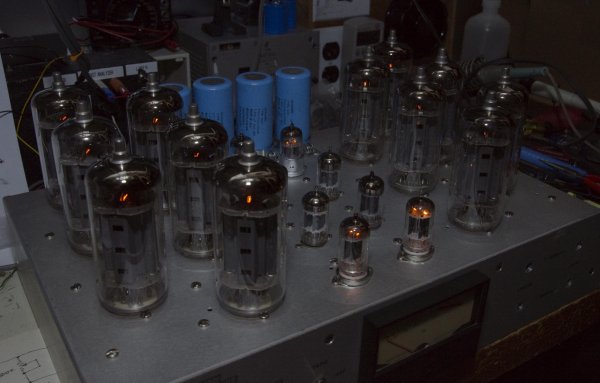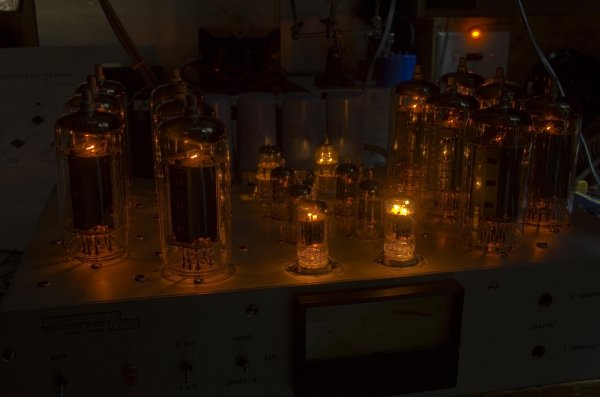Back in the '60s, I built an OTL with 8020 triodes. It produced a modest 25 watts into 16? loads.
After many years of tubes, then building the ultimate audio system over a 38 year period, I am back to tinkering for pure pleasure in the lab. So my fascination with OTL VT amps resurfaced after a long slumber, and I've started a new project, on a bigger scale and more radical design approach.
To wit, here's a photo of the early construction phase. Here we see a stereo amplifier. The right channel fully populated with Beam Tetrodes. The amp topology employs 12 Beam Tetrodes and 8 dual triodes.

Output topology is loosely based on Circlotron designs. It is a self-balancing, DC coupled circuit. The challenge I've undertaken in this amplifier is to have it totally DC coupled from input to output. This requires multiple floating power supplies.
In this design, I'm using Schottky fast recovery diodes with 35 amp capacity for the output tubes. You might say that sounds like a lot of current, but these tubes are quite different. Instead of 6800? plate resistance, we are talking about 80? plate resistance. Even lower, with a circuit to modulate the screen grids with the audio signal, in addition to the control grids, greatly increasing peak power handling and current. The particular tubes can draw up to 1800mA of plate current at 175V DC. Six of these tubes per channel should provide a conservative 150 watts from DC to 500KHz.
Particular attention must be paid to the driver and phase inverter, given the grid damping when the outputs are driven to full power. A 5687 was chosen for the Split Cathodyne phase inverter, due to it's high transconductance and ability to drive lower impedance loads. Circuitry will be balanced nearly all the way to the input, and maybe all the way, if I need to have common mode rejection to isolate the ground from other equipment (you see, this amplifier has NO transformers in it and connects direct to the AC mains).
Solving the filament powering was another challenge. My approach is to use a TRIAC with filtering, followed by a bridge rectifier and DC smoothing capacitor. The filaments are in a series string, using 76 volts at 2.5 amps. The smaller tubes are in series too, using 96 volts at 150mA. These will be powered off a separate DC supply.
Making the amp totally transformerless brings many challenges with it. One is to design a truly floating input that has high CMRR. Another is keeping TRIAC switching noise out of the audio. These and other engineering challenges await, as I continue to build this amplifier. But with no transformers to limit current, this amplifier should have ample reserve of power delivering ability, over a wide and flat frequency response. I hope to have it perfected by next March, in time for the 2nd Annual B.A.S.S Meeting.
After many years of tubes, then building the ultimate audio system over a 38 year period, I am back to tinkering for pure pleasure in the lab. So my fascination with OTL VT amps resurfaced after a long slumber, and I've started a new project, on a bigger scale and more radical design approach.
To wit, here's a photo of the early construction phase. Here we see a stereo amplifier. The right channel fully populated with Beam Tetrodes. The amp topology employs 12 Beam Tetrodes and 8 dual triodes.

Output topology is loosely based on Circlotron designs. It is a self-balancing, DC coupled circuit. The challenge I've undertaken in this amplifier is to have it totally DC coupled from input to output. This requires multiple floating power supplies.
In this design, I'm using Schottky fast recovery diodes with 35 amp capacity for the output tubes. You might say that sounds like a lot of current, but these tubes are quite different. Instead of 6800? plate resistance, we are talking about 80? plate resistance. Even lower, with a circuit to modulate the screen grids with the audio signal, in addition to the control grids, greatly increasing peak power handling and current. The particular tubes can draw up to 1800mA of plate current at 175V DC. Six of these tubes per channel should provide a conservative 150 watts from DC to 500KHz.
Particular attention must be paid to the driver and phase inverter, given the grid damping when the outputs are driven to full power. A 5687 was chosen for the Split Cathodyne phase inverter, due to it's high transconductance and ability to drive lower impedance loads. Circuitry will be balanced nearly all the way to the input, and maybe all the way, if I need to have common mode rejection to isolate the ground from other equipment (you see, this amplifier has NO transformers in it and connects direct to the AC mains).
Solving the filament powering was another challenge. My approach is to use a TRIAC with filtering, followed by a bridge rectifier and DC smoothing capacitor. The filaments are in a series string, using 76 volts at 2.5 amps. The smaller tubes are in series too, using 96 volts at 150mA. These will be powered off a separate DC supply.
Making the amp totally transformerless brings many challenges with it. One is to design a truly floating input that has high CMRR. Another is keeping TRIAC switching noise out of the audio. These and other engineering challenges await, as I continue to build this amplifier. But with no transformers to limit current, this amplifier should have ample reserve of power delivering ability, over a wide and flat frequency response. I hope to have it perfected by next March, in time for the 2nd Annual B.A.S.S Meeting.




